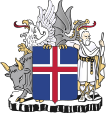|
1903 Icelandic parliamentary election
Parliamentary elections were held in Iceland in June 1903.[1] Electoral systemThe 30 elected members of the Althing were elected from single or double member constituencies by a three-round system; in the first two rounds, a candidate receiving a majority of the vote was elected; if seats were still unfilled after the second round, a third round was held using first-past-the-post voting.[2] Voting took place at a single polling place in each constituency and was done publicly.[2] A further six members were appointed to the upper house by the Danish monarch.[3] Suffrage was limited to men aged 25 or over who were not in receipt of poor relief and who met one of several set requirements including being a civil servant, being a graduate of a university or seminary, or meeting various tax criteria (for farmers, paying more than the minimum tax; for burghers or fishermen, paying eight króna of local taxes; for property owners, paying twelve króna of local property taxes).[3] This limited the number of voters to 7,786 from a population of 79,632.[4] Results4,155 of the 7,786 registered voters participated in the elections.[4] The result was a victory for the Home Rule Party.[5] References
|
